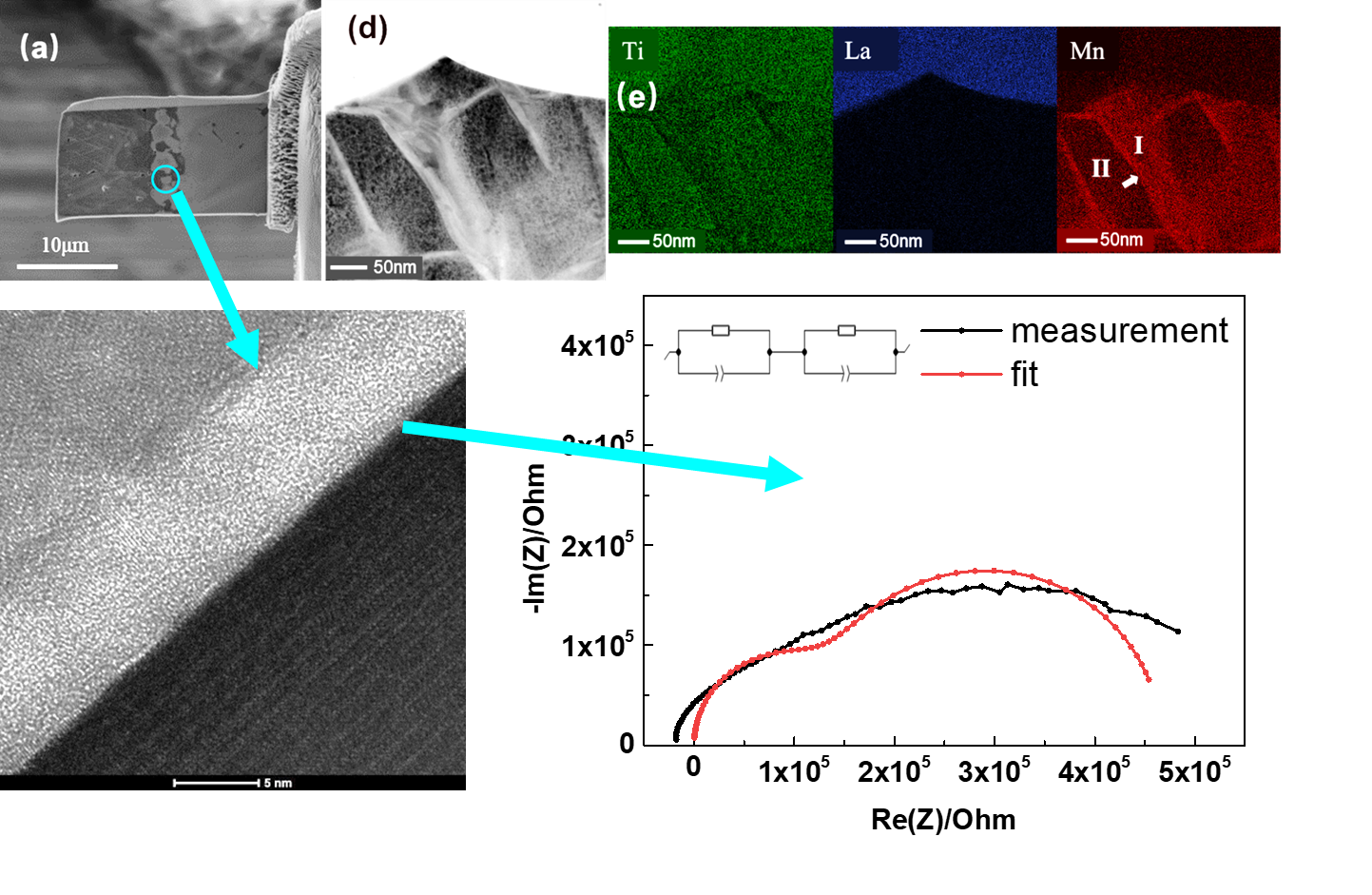Interfaces in
functional ceramics: How to tweak material's properties?
Wolfgang's research group on
interfaces focusses on the fundamentals of interfaces in functional
ceramics,
specifically, the impact on processing and electric properties. The
focus is on
interfaces in ionic conductors for Li, H and O conducting
electrochemical
systems.
Interfaces
play a key role in materials processing and microstructure evolution of
ceramic
materials. Beyond that, many material’s properties are dominated by
interfacial
properties. This is most notable for mechanical properties of ceramics
where
the overall fracture behavior depends on the grain boundary structure.
For the
classical engineering ceramics silicon nitride and alumina, grain
boundary
fracture is well-known to depend on the formation of amorphous layers
depending
on the dopant concentrations. In alumina and many other systems, the
thermodynamics of these layers were investigated in detail
(‘complexions’). It
was shown that the complexions follow phase-like behavior enabling the
investigation of grain boundary phase and TTT diagrams.
But also
conducting materials critically depend on the conductivity of internal
interfaces. In most ceramic systems, such interfaces involve a charged
core
with an adjacent space charge. As soon as charge carriers are
transported
through the material, this space charge acts as Schottky barrier
resulting in
very low grain boundary conductivity. This poses a significant problem
for
applications in the field of ionic conductors as e.g. electrolytes in
SOFC or
solid-state electrolytes for Li batteries. Particularly, the
performance of CeO2,
LixLayTiO3 and BaZrO3
suffers from
poor grain boundary conductivity due to space charge.
For a few
model systems (alumina, zirconia, titania and strontium titanate), our
knowledge on the relationship between fundamental thermodynamics (i.e.
defects
and their chemistry) and some grain boundary properties is relatively
well
established. Beyond these systems, little is known on interfaces and
their
properties. This proposed project aims on both completing our knowledge
on
model systems and extending our current modelling such that space
charge is
added to the complexions framework. But more importantly, this
framework and
knowledge will be extended to more complicated material systems that
have a
higher relevance for electronic applications.
In this
regard, not only equilibrium situations are of interest, but also the
kinetics
of grain boundary phase transitions. If grain boundary phase and TTT
diagrams
can be established, roadmaps for tailored processing, microstructure
evolution
and optimized grain boundary properties become available.
Grain
growth transitions in functional ceramics

In general,
microstructure evolution is believed to be a thermally activated
process due to
its dependence on mass transport by diffusion. However, in functional
ceramics
as the perovskite SrTiO3 and related materials,
non-Arrhenius
behavior occurs during microstructure evolution: at higher
temperatures, finer
microstructures can occur. This unexpected behavior is associated with
bimodal
microstructures and segregation. Its complete understanding allows
tailoring
microstructures according to a given need. Controlling the grain growth
rate
allows well-controlled unimodal fine-grained or coarse microstructures.
Even
quasi-single crystalline microstructures can be obtained with grains of
a size
of 100ds of µm, if segregation and space charge are carefully
engineered. This
high degree of microstructure control offers immense potential to
tailor
properties: both ionic and electronic conductivities of grain
boundaries are of
central importance e.g. for proton conductors (BaZrO3), Li
conductors (LixLayTiO3) and oxygen
conductors
(CeO2) and many other applications.
References
W.
Rheinheimer & M. J. Hoffmann: ‘Grain growth in perovskites:
What is the impact of boundary transitions?’, Current Opinion in Solid
State
and Materials Science, 2016
W.
Rheinheimer & M. J. Hoffmann: ‘Non-Arrhenius behavior of grain
growth in
strontium titanate: New evidence for a structural transition of grain
boundaries’, Scripta Materialia, 2015
W.
Rheinheimer, M. Bäurer & M. J. Hoffmann: ‘A reversible wetting
transition
in strontium titanate and its influence on grain growth and the grain
boundary
mobility’, Acta Materialia, 2015
Simulation
of bimodal grain growth
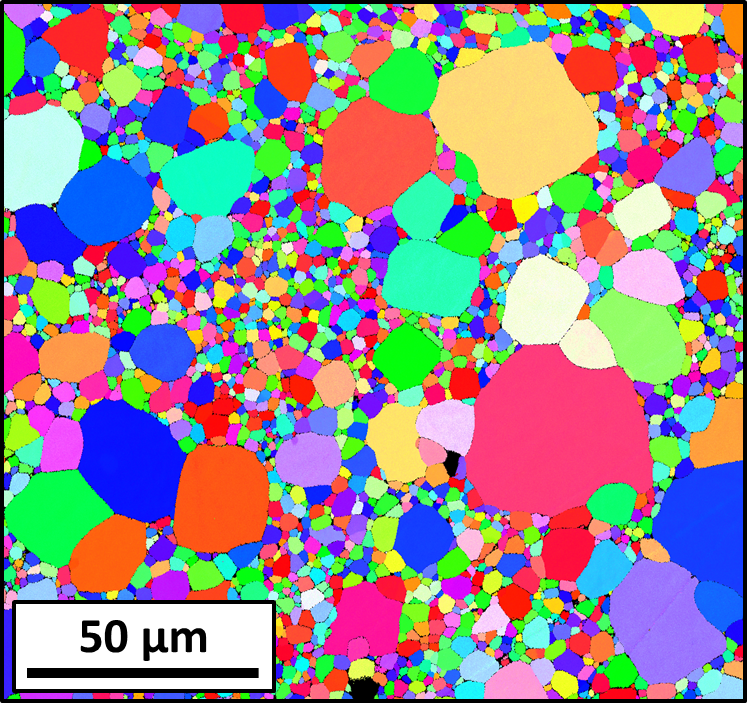
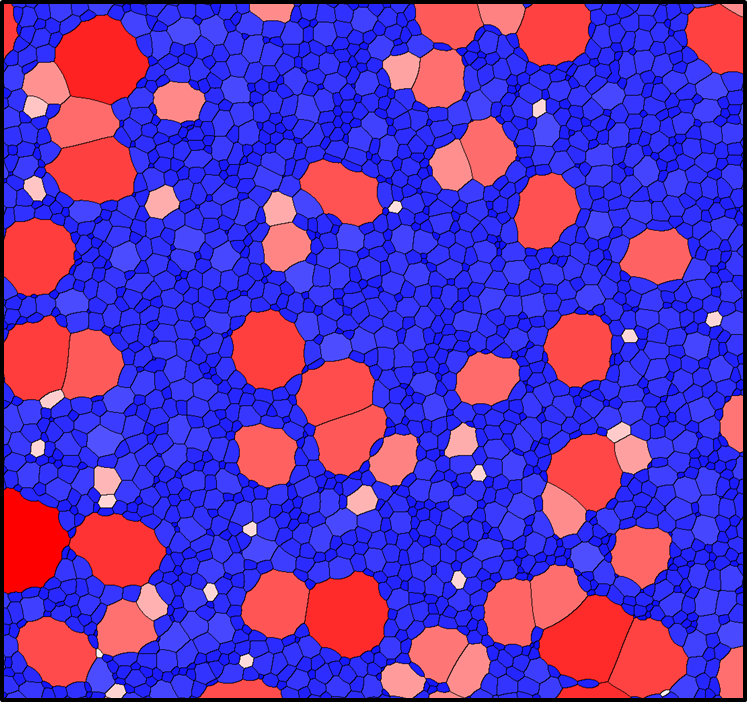
To obtain
full microstructural control, a careful analysis of bimodal
microstructure
evolution is needed. This can only be achieved by establishing a
digital twin,
e.g. using a phase field model for bimodal microstructure evolution.
The obtained
numbers allow investigating nucleation behavior of bimodal
microstructures.
References
W.
Rheinheimer, E. Schoof, M. Selzer, B. Nestler & M. J. Hoffmann:
„Non-Arrhenius grain growth in strontium titanate: Quantification of
bimodal
grain growth“, Acta Materialia, 2019
Anisotropy
and its impact on microstructure evolution
Due to the
crystalline nature of ceramics, lattices have anisotropic properties.
As a
consequence, all grain boundary properties are anisotropic as well,
e.g. the
grain boundary energy, and mobility, but also electric properties and
segregation. To evaluate the impact of anisotropy on microstructures
and
properties, careful model experiments are needed. For example, the
anisotropy
of the grain boundary energy can be approached by observing the shape
of pores or
grains in microstructures. Statistical approaches reveal the texture of
the
grain boundary plane orientation (Grain Boundary Plane distribution)
and allow
the identification of important grain boundary configurations.
References
W. Rheinheimer,
C. A. Handwerker
& J. E. Blendell: ‘Equilibrium
and kinetic shapes of
grains in polycrystals’,
Acta Materialia, 2020
W.
Rheinheimer, D. Lowing &
J.E. Blendell: ‘Grain growth in NiO-MgO and its dependence on faceting
and the
equilibrium crystal shape’, Scripta Materialia,
2020
W.
Rheinheimer, Fabian J.
Altermann & M. J. Hoffmann: ‘The equilibrium crystal shape of
strontium
titanate: Impact of donor doping’, Scripta
Materialia, 2017
W.
Rheinheimer, M. Bäurer, H. Chien, G. S. Rohrer, C. A. Handwerker, J. E.
Blendell & M. J. Hoffmann: ‘The equilibrium crystal shape of
strontium
titanate and its relationship to the grain boundary plane
distribution’, Acta
Materialia, 2015
W.
Rheinheimer, M. Bäurer, C. A. Handwerker, J. E. Blendell & M. J.
Hoffmann:
‘Growth of single crystalline seeds into polycrystalline strontium
titanate:
Anisotropy of the mobility, intrinsic drag effects and kinetic shape of
grain
boundaries’, Acta Materialia, 2015
Space
charge, grain boundary segregation and solute drag in functional
ceramics

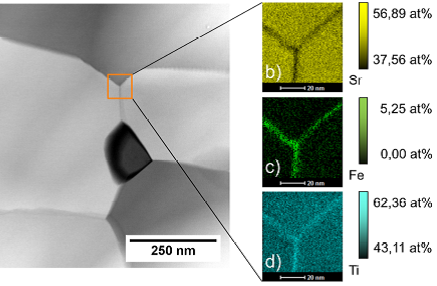
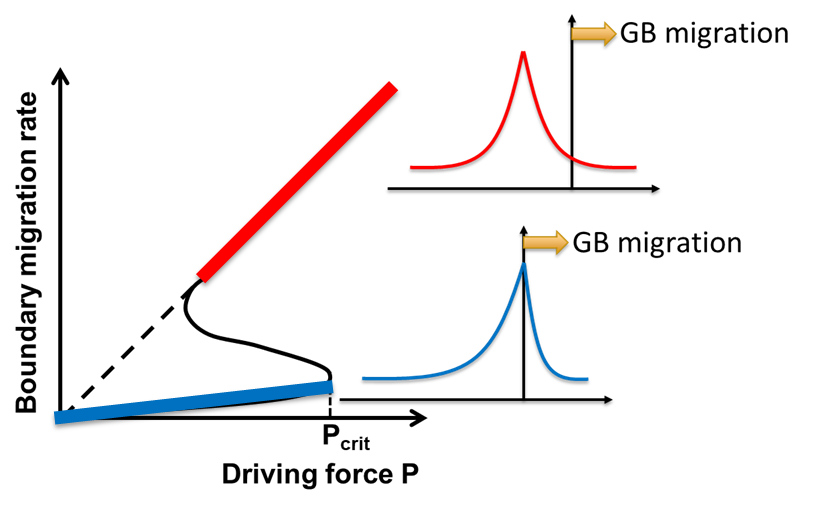
Space
charge
at a grain boundary forms for thermodynamic reasons: The grain boundary
is a 2D
lattice defect and results in a fraction of broken bonds and, as a
result,
lattice stresses. In response, the grain boundary restructures by
segregating
point defects to the grain boundary core. As these defects bring a
charge to
the grain boundary plane. This charge is shielded by an accumulation of
point
defects with inverse polarity next to the grain boundary core. Space
charge and
segregation are common in functional ceramics and sometimes decrease
the
performance by orders of magnitude due to the resulting Schottky
barriers. Less
well-known is the dependence of microstructure evolution on space
charge:
segregated defects can dominate densification and grain boundary
migration. The
underlying physics are known since the 60s from metals (‘solute drag’).
Accordingly,
tailoring microstructure evolution in functional ceramics for a given
application needs a fundamental understanding of space charge and
segregation.
This fundamental understanding is supported by well-established models
from the
metals community that need to be extended to account for the additional
complexity of ionic polycrystals.
References
W.
Rheinheimer & M. J. Hoffmann: ‘Grain growth in perovskites: What is
the
impact of boundary transitions?’, Current Opinion in Solid State and
Materials
Science, 2016
K.S.N.
Vikrant, W. Rheinheimer, H. Sternlicht, M. Bäurer & R. E. García:
‘Electrochemically-driven
abnormal grain growth in ionic ceramics’, Acta Materialia, 2020
K.
S. N Vikrant, W. Rheinheimer, & R. E. García: ‘Electrochemical drag
effect
on grain boundary motion in ionic ceramics’, npj Computational
Materials, 2020
W.
Rheinheimer, X. L. Phuah, H. Wang, F. Lemke, M. J. Hoffmann & H.
Wang: 'The
role of point defects and defect gradients in flash sintering of
perovskite
oxides’, Acta Materialia, 2019
W.
Rheinheimer, J. P. Parras, J.-H. Preusker, R. A. De Souza & M. J.
Hoffmann:
‘Grain growth in strontium titanate in electric fields: The impact of
space
charge on the grain boundary mobility’, Journal of the American Ceramic
Society, 2019
Grain
boundary adsorption and its interplay with functional properties
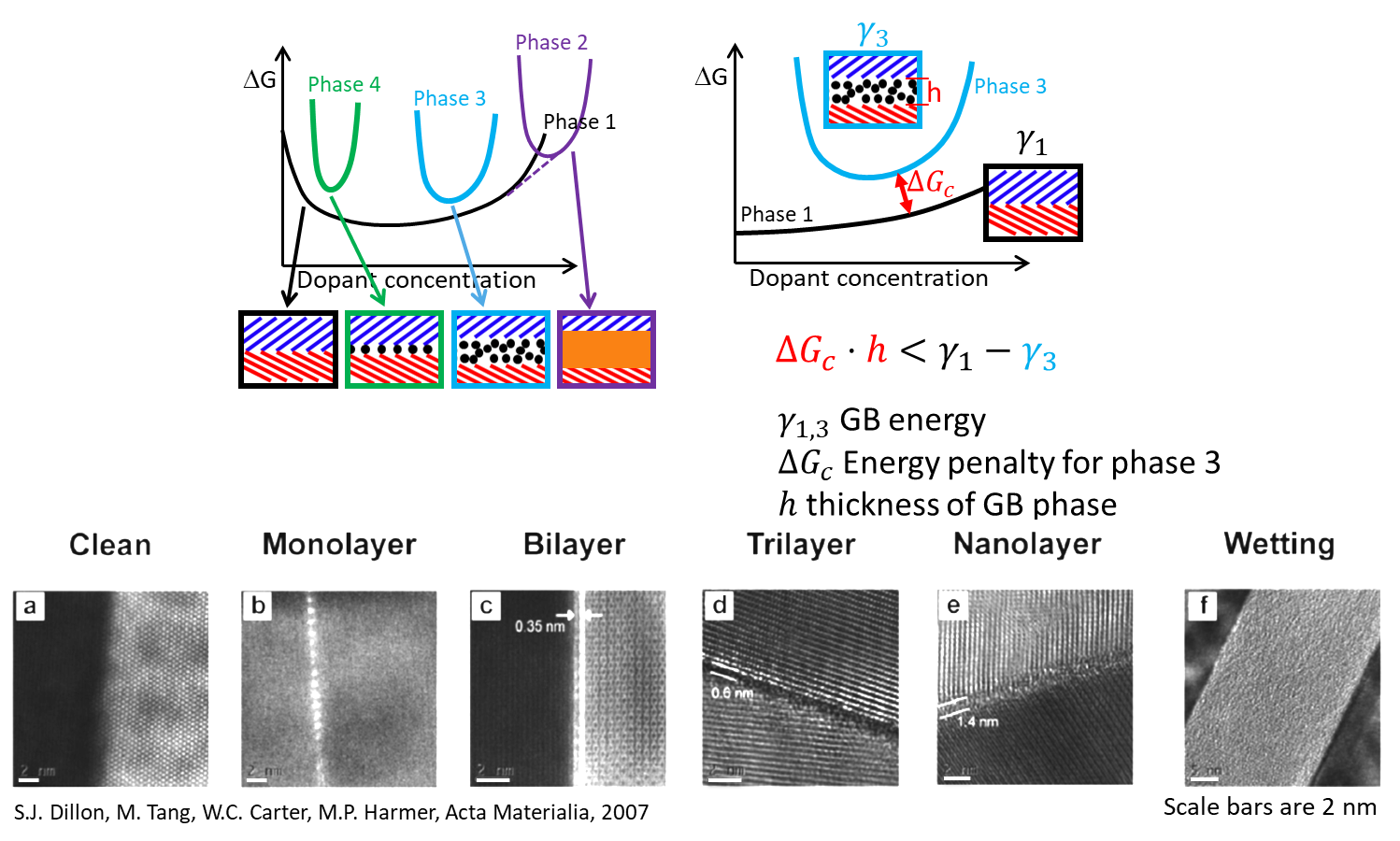
The
occurrence of adsorption and grain boundary phases in ceramic materials
is
known since the 90s, when the engineering ceramic Si3N4
was the investigated in detail. This concept bases on the thermodynamic
stabilization of adsorption layers by a reduction of the grain boundary
energy
and is known under the terms critical wetting, intergranular glassy
film (IGF)
or complexion.
Recently, the
phenomenon of grain boundary phases was revisited in the context of
microstructure evolution and functional properties. For example, in
LMO-LLTO
half cells for solid state batteries, nm-thick layers of amorphous
grain
boundary phases result in enormous interfacial resistance. Such an
interface is
unusable for solid-state batteries.
References
P. Xu, W.
Rheinheimer, S.N. Shuvo, O. Levit, Y. Ein-Eli & L. Stanciu: ‘Origin
of high
interfacial resistances in solid-state batteries: interdiffusion and
amorphous
film formation in LLTO/LMO half cells’, ChemElectroChem,
2019
W.
Rheinheimer & M. J. Hoffmann: „Grain growth in perovskites: What is
the
impact of boundary transitions?“, Current Opinion in Solid State and
Materials
Science, 2016
W.
Rheinheimer, M. Bäurer & M.
J. Hoffmann: ‘A reversible wetting transition in strontium titanate and
its
influence on grain growth and the grain boundary mobility’, Acta Materialia, 2015
Grain
boundary structure and microstructure evolution
On atomistic
scale, the motion of grain boundaries is believed to base on the
movement of
steps and grain boundary dislocations (‘disconnections’). This
mechanism is overlaid
by other grain boundary effects as e.g. space charge and solute drag.
References:
H.
Sternlicht, W. Rheinheimer, A. Mehlmann, A. Rothschild, M. J. Hoffmann
& W. D. Kaplan: „The mechanism of grain growth at general grain
boundaries in SrTiO3“, Scripta Materialia, 2020
H. Sternlicht, W.
Rheinheimer, R. E. Dunin-Borkowski, M. J. Hoffmann & W. D. Kaplan:
‘Characterization of grain boundary disconnections in SrTiO3 part I:
The dislocation component of grain boundary disconnections’, Journal of
Materials Science, 2019
H. Sternlicht, W.
Rheinheimer, J. Kim, E. Liberti, A. I. Kirkland, M. J. Hoffmann &
W. D. Kaplan: ‘Characterization of grain boundary disconnections in
SrTiO3 part II: The influence of superimposed disconnections on image
analysis’, Journal of Materials Science, 2019











